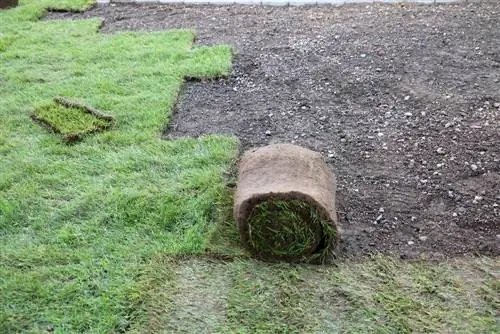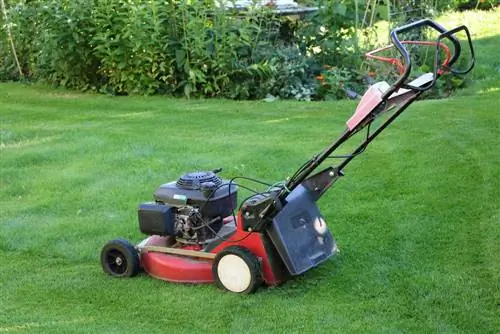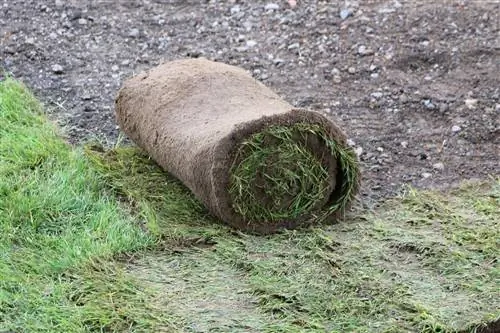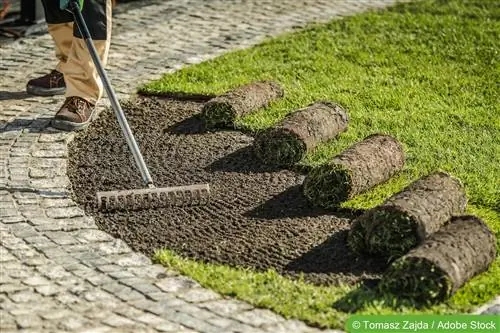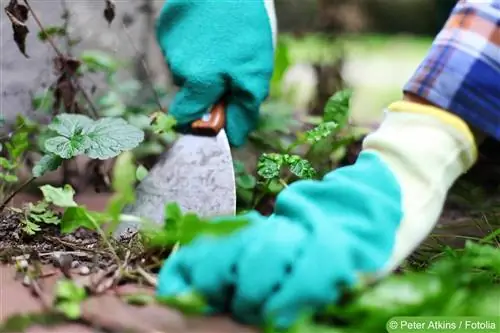- Author admin [email protected].
- Public 2023-12-17 03:39.
- Last modified 2025-06-01 06:48.
Elaborate ground preparation, not so complex but exciting installation - now the turf is in place and ready to be enjoyed, but definitely don't forget to take care of it in the first year, otherwise the enjoyment will soon come to an end:
Mowing turf in the first year
Grasses have developed into extensive ground vegetation in natural landscapes and are used as such in cultivated landscapes because the plants in their entire growth form (renewal buds close to the ground, protective leaf sheaths on the stalk, numerous partial inflorescences on particularly flexible stalks) are geared towards this to be eaten away. A grass plant doesn't mind having its upper part constantly removed, whether by a sheep, cow or lawnmower.
Since every single stalk and every single plant has a microscopically different growth rate, lawns that are neither eaten nor mowed develop into green areas with plants of very different heights and strengths. The more often you bring the grass plants to the same height and thus equalize the growth conditions for the individual plants (different growth increases, the plant with longer stalks is also stronger and requires more nutrients than its weaker neighbor), the more uniform the individual grass plants will become develop.
The optimal result of such efforts to provide every grass plant with the same growing conditions through care and mowing looks like an area of 5 cm stalks placed close together and is called an “English lawn”. In order to prevent the individual plants from growing differently right from the start, a young lawn is mowed as early as possible, regardless of whether it is the young stalks of a sowing or a turf that is new to the site.
In the question of when a turf should be mowed for the first time and the sometimes contradictory answers to this question in the care instructions, it is particularly noticeable that the turf is not a completely normal lawn after all. Normal lawns are expected to grow for a few weeks or a few months before they are put under pressure, whereas turf is promised to be ready to walk on in just a few days.
That's true, there's a strong lawn upstairs that's up to 1.5 years old, why shouldn't you walk on it? It's just that the roots underneath are still busy growing - and when on the one hand you read that the turf should be watered well during the growth period of 14 days and, if possible, not walked on, but on the other hand it is recommended to mow it for the first time after a week at the latest, this seems to contradict itself.
For “experts of the scene” and attentive observers, there is no contradiction in these statements. What this means is that the turf should be mowed for the first time when it has grown to the point where the roots are already feeding on the soil. Because from this (of course very sliding) moment the plant mass in the upper area also begins to grow, from then on the lawn should be mowed as often as possible because each mowing makes it more even and cutting the blade stimulates growth and branching.
Therefore, the first mowing is done when a rolled turf delivered with a length of 4-5 cm is on average 6-7 cm high (or a rolled turf delivered with a length of 3-4 cm is on average 5-6 cm high; that is but only conceivable with very fine turf qualities, because with sports turf such deep mowing almost scratches the root system).
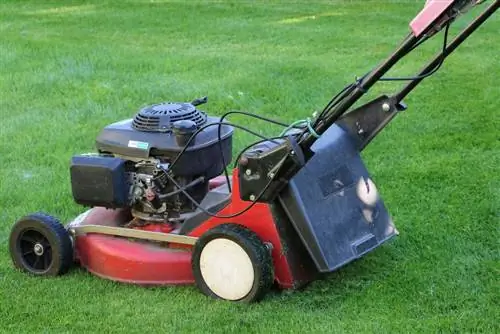
The lawn should not be watered for a day or two beforehand so that it is easier to walk on; and it would be much cheaper if the 45 kg offspring got to work with the old, but sharp and light hand lawn mower than if the 110 kg head of the family inaugurated the heavy new mowing machine. When mowing for the first time (or whenever you have an area in mind that resembles an English lawn), no more than 2 cm should be mowed anyway.
Since hardly anyone can do this, you can remember the following rule of thumb for future mowing: Mow at least once a week, but do not take away more than a third of the height - if you wait longer, then it might still be too short If you mow to increase the distance between the next mowing, you run the risk of individual grass plants giving up and no longer forming new shoots, which can create holes in the lawn. Mowing is always too short if the mown lawn is noticeably lighter than the unmown lawn, so set the mower a little higher.
In the beginning you should only mow the really dry (dried) lawn; and only mow when 2 - 3 cm have grown back. You should also not leave the grass clippings on the lawn in the beginning, even if you have bought a mulching mower and plan to leave the clippings on the lawn as organic fertilizer as part of organic fertilization. The lawn, which has been watered diligently to grow, is already at increased risk of fungi at this stage, which would be further promoted by compaction with moist clippings. After about 14 days you can carefully walk on the turf more often, but only after about six weeks will it be so completely rooted that it forms a unit (and can probably handle the first football game).
Tip:
If there are a lot of fungal spores flying through the air in the new location, brownish cap fungi can develop during/shortly after the intensive irrigation that is necessary in the early stages for the roots to grow. This is not a defect, but normal given the weather - the fungi will disappear if the watering is reduced to normal after the turf has grown.
Fertilize turf in the first year
Depending on how the course was laid during the ground preparation, the turf is fertilized as follows in the first year:
Conventional synthetic mineral fertilizer (artificial fertilizer)
If you fertilize conventionally, you have applied starter fertilizer and hopefully had the nutrient requirements determined by soil analysis before applying this starter fertilizer. In this case, you know what to fertilize, but you may just not know exactly when the lawn should be fertilized for the first time. With conventional fertilization, this ultimately depends on the supply from the supplier or whether you ordered the turf pre-fertilized. In general, it is recommended to start fertilizing 4 - 6 weeks after the turf has established (first mowed); Depending on the pre-fertilization, half or the whole amount recommended in the soil analysis.
If you fertilize without soil analysis, you can follow the manufacturer's instructions/suggestions; However, the more the new location becomes noticeable, this type of fertilizing becomes “fertilizing blindly”. What is less recommended today than ever before: The amounts of manure that are spread by agriculture are already polluting the groundwater enough; Sensible fertilizing is always targeted fertilizing, an important prerequisite for the long-term prosperity of the turf.
So if in doubt, you should get the soil analysis done as quickly as possible so that you can then treat the lawn with the recommended fertilizer. If you search for “soil analysis” + “hometown”, you can find a soil analysis company near your home town from your municipality’s environmental office or from the Internet. In the first year, you should be cautious about any fertilizer recommendations as long as the lawn is growing well - a little effort only makes the lawn stronger.
Even later, in a “conventional” garden, i.e. using artificial fertilizers and pesticides, you should make sure to have the next soil analysis carried out in good time, because the fast-acting fertilizer is only somewhat tolerable for soil life as long as it lasts it is not over-fertilized.
Organic fertilization
If you want to have little work on your lawn, you should not endanger the soil life with mineral fertilizers, but rather feed it with organic fertilizer.
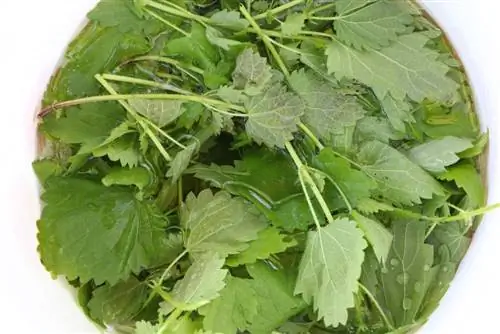
There are numerous arguments for organic fertilization, the most important of which are: B. can be found in the article “Lawn care in spring - how to lime, fertilize and mow correctly”; and there are comprehensive, fascinating treatises on the whole topic online, e.g. B. can be accessed here: www.planet-wissen.de/natur/umwelt/lebendiger_boden/pwiebodenleben100.html.
Which is why the practical side should be discussed here: In a naturally maintained garden soil, this organic fertilization feeds millions of soil organisms per square meter, which do crucial gardening work for you completely free of charge. Which means, the other way around, that you don't have much to do in an organically fertilized garden where a certain balance has been established.
You can plant and sow without difficult soil preparation, only for particularly frugal or particularly hungry plants may a little sand or a little nutrient need to be added; and you should be careful not to reduce the diversity of soil life by putting the same plants in the same locations for years. Otherwise, you still have to cut the plants that need regular pruning and think about where in the garden the clippings should best rot; If the weather is far too dry, water something at some point (whereby a well-supplied soil with mulch or plant cover stores much more moisture than a “bare” mineral fertilizer soil) and continually add a colorful mixture of nutrients that are processed by the soil organisms (which also like lots of household leftovers) - that's it, little work, lots of garden.

Looked at this way, all gardeners appear to be “powdered with a bag of staples” who constantly buy mineral fertilizer for expensive money, distribute it at great expense after sending the soil for soil analysis with some effort, spend several afternoons a month doing it, To chop up and package plant residues for disposal and of course to combat all the plant diseases and pests (expensive and time-consuming) that regularly occur in “conventionally managed gardens”.
Now a garden is not immediately in ecological balance, but needs a little support from the gardener to achieve this balance (surprisingly little in the casually overgrown perennial garden, a little more in the ornamental and utility garden, which is completely covered with useful plants); and organic fertilization is only recommended for people who can tolerate at least some nature (including natural clutter) in their garden.
But conventional in the sense of traditional and natural, there is only as much about this “conventional garden tour” as the salesman at the nearest garden center will allow you if or because he realizes that he can no longer sell here.
The switch to organic fertilization
As more and more people are becoming aware of this, natural gardening with organic fertilization is currently experiencing a huge upswing. More and more people are therefore switching to organic fertilization, which again raises its own questions:
If you have already switched to organic fertilizer, but have laid a turf that has been pre-fertilized with mineral fertilizer, you can use compost when preparing the soil, the starter fertilizer provided shortly before laying (small amounts) and 4-6 weeks after it has grown organically -Apply mineral lawn fertilizer, so first mix both fertilizers. In the future, reduce the amount of mineral fertilizer more and more in favor of long-acting, slow-acting organic fertilizers; If the lawn threatens to slip into deficient conditions from time to time, liquid fertilizer available to plants quickly from the market or in the form of plant manure will help.
If the switch to organic fertilization should begin with laying the turf, you can basically do the same thing; the change just takes a little longer. Once it's done, you'll have to spend less and less time fertilizing. Initially a little more to apply organic lawn fertilizer from the market; If you enjoy circular fertilization, at some point the lawn will probably only be supplied with compost, shredded plant matter from the mulching mower and household waste.
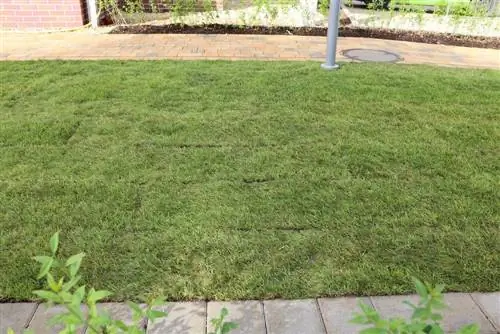
What's left in the household contains many nutrient-rich substances that can be fed to the plants. You can find a compilation of "natural fertilizers to whet your appetite" for example. B. in the article “Fertilize geraniums perfectly - the best geranium fertilizers and home remedies”. The list is long, from aquarium water (with potassium and nitrogen) to fireplace ash (rich in potassium and lime, iron and phosphate), from coffee grounds (which can replace a complete fertilizer) to baking soda (which contains moss in acidic lawn soil pH value corrected so that the moss has a harder time in the future).
The list of course continues in the garden: Fertilizer is made from substances such as plant meal (from chopped plant residues), which is of course added to the compost; Horse manure (which has been stored for at least a few months), horn shavings from the riding stables and manure from our own weeds (e.g. B. Nettles as fertilizer in fermented and widely diluted form; the fresh approach is one of the most important natural plant protection products). In the garden area, guano is also sometimes produced, one of the best organic fertilizers, which is created when birds defecate on limestone - guano is also produced under the bird feeder that hangs over a limestone paving area; it just has to evaporate on the compost for a while. And if all of this is in short supply, organic liquid fertilizer can help (which actually fertilizes the potted plants indoors, but also gives the lawn quickly available nutrients if it is needed in between).
Since organic fertilizers first have to be decomposed by soil organisms and the lawn with its dense network of roots is better at absorbing at least half decomposed fertilizer, all of these substances should first be added to the compost in order to fertilize the lawn with or through them (lightly rake in). Grass clippings can only rot on the lawn if they have been chopped into small pieces using a lawn mower with a mulching function.

